Abstract
This study designed a control system for the automatic unloading and replenishment of baskets based on the cooperative detection of photoelectric sensors and pressure sensors based on analyzing the structure of the 4UM-120D electric leafy vegetable harvester. The goal of this study was to increase the operation efficiency of leafy vegetable harvesters and decrease the work intensity of operators. A control system for the automatic unloading and replenishment of baskets based on the cooperative detection of a photoelectric sensor and pressure sensor was designed and constructed after an analysis of the operating principle and system components of automatic basket unloading and basket replenishment control at the rear of the harvester. The bench test results showed that the bottom photoelectric sensor and top photoelectric sensors 1 and 2 on the touch screen were not lit and the pressure sensor value was displayed as −0.00075531 kg, after pressing the system start button on the touch screen. On the touch screen, only the basket feeding motor was on: the transverse conveyor motor and the basket unloading motor were not, indicating that there was no collection basket on the unloading basket conveyor belt at this time and that the basket feeding motor was conveying an empty basket to the unloading basket conveyor belt. At 26 s, on the touch screen, only the top photoelectric sensor 2 was not on: the top photoelectric sensor 1 and the bottom photoelectric sensor were on and the pressure sensor value was shown as 1.38488 kg. Only the transverse conveyor motor lit up on the touch screen, the basket unloading motor and the basket feeding motor did not light up, indicating that the leafy vegetables temporarily stored in the transverse conveyor belt started to fall into the collection basket at this time and had not yet reached the expected capacity of the collection basket. At 43 s, the bottom photoelectric sensor and top photoelectric sensors 1 and 2 were lit on the touch screen and the pressure sensor value was shown as 2.37229 kg. On the touch screen, only the basket unloading motor lit up: the transverse conveyor motor and the basket feeding motor were not lit up, indicating that the collection basket capacity had reached the expected capacity at this time and the unloading was in progress. At 83 s, the bottom photoelectric sensor and top photoelectric sensors 1 and 2 were not lit on the touch screen and the pressure sensor value was displayed as −0.0040102 kg. On the touch screen, only the basket feeding motor lit up: the transverse conveyor motor and the basket unloading motor did not light up, indicating that the collection basket with the expected capacity had been unloaded to the ground, and the basket feeding motor was transporting empty baskets to the basket unloading conveyor belt. Through bench simulation tests, it was determined that the control system for the automatic unloading and replenishment of baskets based on the cooperative detection control strategy of the photoelectric sensor and pressure sensor reduced the probability of misjudgment and misoperation and improved system performance. This was conducted with the probability of system misjudgment and misoperation serving as the main evaluation index. The simulation results demonstrated that the control system for the automatic unloading and replenishment of baskets based on a photoelectric sensor and pressure sensor cooperative detection control strategy could be error-free judgment and avoid misoperation, effectively improving the stability, accuracy, and rapidity of the system. The study’s findings could suggest a strategy to lessen the workload of operators and increase the operational effectiveness of harvesters for leafy vegetables.
1. Introduction
China is the nation where the greatest diversity and range of vegetables are grown and its output makes up nearly half of the global total. In 2021, the country’s national vegetable sowing area was over 21,744,300 hectares and it produced 782 million tons of vegetables, ranking first in the world with an average intake of nearly 500 kg per person [1,2,3]. Leafy vegetables are a collection of vegetables that typically feature fresh leaves, petioles, and stalks as the edible section. They are distinguished by a quick growth cycle and labor-intensive harvesting [4]. Due to the wide variety of leafy vegetables grown in China, as well as the noticeable variations in planting density, planting style, and growth characteristics of various leafy vegetables, leafy vegetable harvesting is primarily performed manually [5,6]. With the continuous reduction in the rural labor force and given that the leafy vegetable harvesting industry is a labor-intensive industry, speeding up the development of leafy vegetable harvesting machinery to realize mechanized and intelligent harvesting of leafy vegetables is therefore of great significance to reduce the cost of leafy vegetable production, reduce the labor intensity of manual labor, and promote the development of leafy vegetable harvesting industry [7,8,9].
Over the past few years, a succession of leafy vegetable harvesters have been put to the test for promotional purposes but the level of intelligent technology is low, and various problems that develop in actual use are more frequent [10,11]. In the current domestic leafy vegetable harvesting operations, the majority of manual unloading collection baskets and replenishment collection baskets, as well as manual unloading and replenishment baskets, need to stop working. According to the actual harvesting situation, the average cycle of manual unloading and replenishment of baskets once is about 15 s, the machine needs to stop in the 15 s, seriously affecting the harvesting efficiency while increasing the work intensity. In the actual operation process, the operator’s professional level is relatively low, making it challenging to keep the leafy vegetable harvester in stable working condition for an extended time. Additionally, the manual unloading and replenishment of baskets is slow, and other situations arise, which not only increases the operator’s workload but also has a significant negative impact on the effectiveness of leafy vegetable harvesting.
Developed countries began research on leafy vegetable harvesting machinery earlier and the use of sensors, machine vision, automation control, and other technologies has considerably expanded harvesting operation mechanization; intelligent technology is reasonably mature [12,13,14]. Some countries and areas, such as the United States, Italy, Japan, and South Korea, have achieved mechanized and intelligent harvesting of leafy vegetables [15,16,17,18,19].
Ortomec Agricultural Equipment Company (USA) has developed a leafy vegetable harvester (In 2011), which mainly includes a cutting device, a conveying device, a cutting height automatic adjustment device, and a collection device. The machine adopted an automatic cutting height adjustment device based on photoelectric sensors, which measures the actual growth height of leafy vegetables and then converts it into a corresponding pulse signal output. The main controller received the output pulse signal and controlled the cutting device to automatically adjust the cutting height but the machine is powered by a diesel engine [20] which causes some pollution to the environment. Figure 1 depicts the SLIDE TW type leafy vegetable harvester created by HORTECH, Italy (In 2016). The machine has a type of corrugated clamping conveyor belt that clamps and moves cut leafy vegetables to the back end for secondary orderly manual bundling. This feature is ideal for leafy vegetables that need to be harvested in an orderly fashion, but it has the drawback that the development of the machine is challenging and difficult to promote to meet the needs of small farmers in terms of production [21]. The SLIDE VALERIANA leafy vegetable harvester (In 2016) is equipped with a soil removal shaker that efficiently removes the clay that adheres to leafy vegetables, resulting in cleaner leafy vegetables collected at the back end. The machine is suitable for harvesting young leafy vegetables [22]. Kawasaki, Japan, has created a wind-fed small leafy vegetable harvester (In 2015) that uses high-pressure airflow to transport cut leafy vegetables to the collection bag at the back end. The benefit of wind-fed conveying is that there is no contact or friction between the cut leafy vegetables and the conveyor belt, which can reduce leafy vegetable damage to some extent and lower the rate of leafy vegetable harvesting damage. The harvesting of small leafy vegetables like clover, chrysanthemum brain, marjoram head, etc., is appropriate for this machine [23]. Figure 2 depicts the TC110E self-propelled leafy vegetable harvester created by Japan Second Industries Co., Ltd. (In 2015). The self-propelled chassis, reciprocating double-action cutter, airflow conveying system, collection bag, etc., are the major components of the machine. Since the cutter and leafy vegetables do not make hard contact during the cutting process, it is possible to guarantee high harvest quality and the basic consistency of leafy vegetable stubble cutting. This machine’s benefits include its great adaptability; capacity to harvest a variety of stemmed leafy vegetables, including sweet potato stem tips; and wide range of cutter height adjustments [24,25].
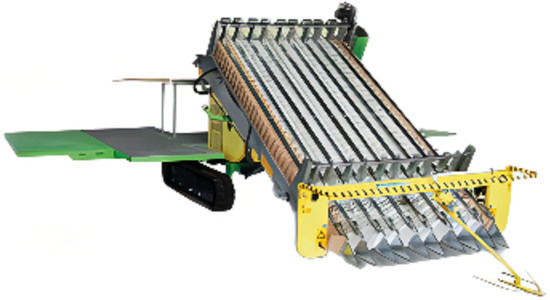
Figure 1.
SLIDE TW leafy vegetable harvester.
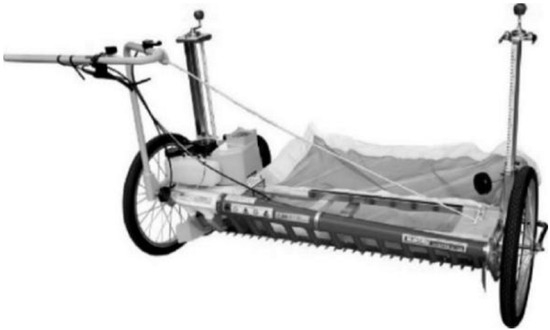
Figure 2.
TC110E self-propelled leafy vegetable harvester.
At the moment, although China is a large country in terms of leafy vegetable production and consumption, leafy vegetable harvesting machinery research is still in its early stage and the development process is slow; the actual field harvesting operations are still dominated by human labor [26,27,28]. The majority of leafy vegetable harvesting machinery is still in the theoretical preliminary study, prototype test stage, focused on device design, structure simulation optimization, and so on, with a low degree of intelligent technology [29,30,31,32,33].
Figure 3 depicts the 4UM-100 leafy vegetable harvester created by Gongpu Wang et al. (2019) at the Nanjing Agricultural Mechanization Research Institute, Ministry of Agriculture and Rural Affairs. The machine has the following benefits: motor-driven, no pollution; reciprocating double-action cutter cutting, with a smooth cut; cutting, paddling, conveying, and traveling are controlled by independent motors, which is easy to use; and the machine is suitable for harvesting stalked leafy vegetables such as sweet potato stem tips, baby bok choy, and chickweed; the disadvantage is that the entire harvesting process is less orderly [34]. The 4UM-120D electric leafy vegetable harvester (In 2020) has a 48 V DC motor travel driving system and a 1.2 m canvas-type conveyor belt. Its cutter is also height-adjustable from the ground, making it possible to harvest both leafy vegetables with upright growth and those with fallen stems [35]. When the 4UM-120D electric leafy vegetable harvester was operating, a DC brushless motor drove the reciprocating double-action cutter to cut at a specific speed. The cut leafy vegetables were first delivered to the conveying mechanism using the paddle wheel, followed by the conveying mechanism’s sending them to the rear outlet. By using the collecting basket to cover the outlet, the collection operation was then finished. Figure 4 depicts a hand-held ordered leafy vegetable harvester that was created by Guangming Qin et al. (2016). The machine uses a reciprocating double-action cutter to cut the leafy vegetables, then pushes the cut vegetables to two vibrating rods that alternately vibrate up and down to clean the surface impurities off the vegetables and to ensure the orderly transport of the vegetables [36]. Yinyan Shi (In 2018) and colleagues from Nanjing Agricultural University created the self-propelled artemisia harvesting device. The machine moves the cut artemisia in an orderly fashion through the clamping and conveying mechanism to the steering mechanism, which then turns the artemisia from vertical to horizontal conveying. The artemisia is then moved in an orderly fashion to the collection basket at the back by the action of the secondary conveyor belt, realizing the orderliness of the entire cutting, conveying, and harvesting process of artemisia [37]. The working principle of the above machines is shown in Table 1.
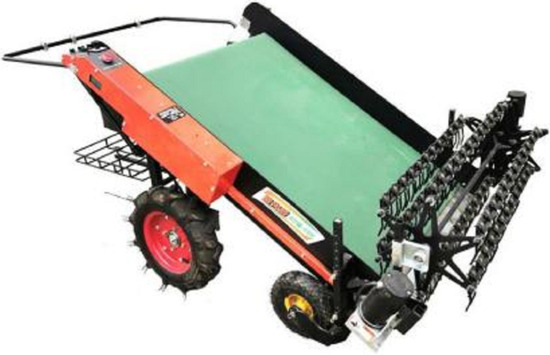
Figure 3.
Nanjing Agricultural Mechanization Research Institute 4UM-100 leafy vegetable harvester.
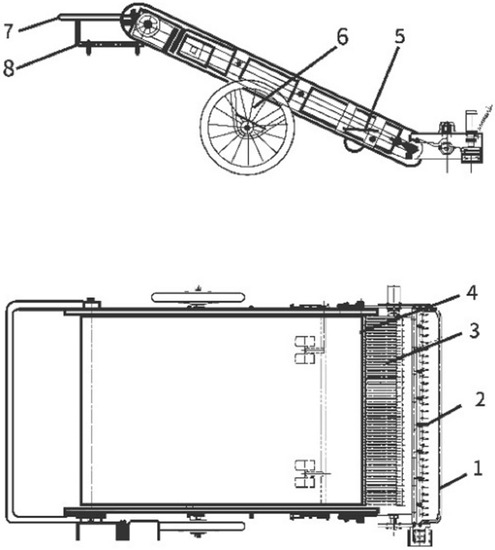
Figure 4.
Hand-held ordered leafy vegetable harvester 1. Safety bar 2. Shear knife assembly 3. Vibrating screen mechanism 4. Conveying mechanism 5. Profiling wheel 6. Traveling wheel 7. Handrail 8. Collecting device.

Table 1.
The working principle of various leafy vegetable harvesters.
In China, the development of leafy vegetable harvesting machinery has been rapid in recent years and the level of intelligent technology has also advanced to some extent. In China, research on the main control elements and systems of leafy vegetable harvesting machines focuses on the intelligent detection of the harvesting device’s height from the ground and the automatic adjustment control system, the automatic row-to-row intelligent regulation system, and the intelligent regulation system of the operating speed.
Jian Zhang et al. (2020) [38] created an automatic control system for their research into harvesting device height above ground detection and automatic adjustment control system. The control system uses ultrasonic sensors to measure the cutting device’s height above the ground. The detection signal is produced, input to the main controller, processed by the main controller, output of the corresponding number of pulse signals, control of the DC drive motor, electro-hydraulic cylinder, and other actuators to automatically regulate the height of the cutter from the ground, so that the height of the cutter from the ground has been maintained at the set value and the system can be based on the actual height of the planting of leafy vegetables. To further advance the level of harvesting machine intelligent science and technology, Yuanyuan Wu et al. (In 2018) developed a suitable machine vision-based scheme to gather data about the height of the cutting table off the ground and navigation parameters of the leafy vegetable harvester [24]. However, due to its time-consuming and expensive nature, it is unsuitable for widespread promotion and application. To automatically adjust the digging depth of the digging shovel while harvesting sweet potatoes, Tao Li et al. (2018) created a 4UGS2 towed two-row sweet potato harvester. This harvester is outfitted with an automatic rapid adjustment digging depth control system [30]. Using a fuzzy PID control strategy and a PLC as the main controller, Peng Miao et al. (2022) researched automatic row-to-row control of a leafy vegetable harvester. They developed a “ball-type” automatic row-to-row detection mechanism and automatic row-to-row control system [5], which is an automatic row-to-row stability, high precision, and fast response speed system.
Accelerating the development of leafy vegetable harvesting mechanization, as well as realizing leafy vegetable mechanization and intelligent harvesting, is critical to lowering leafy vegetable production costs, reducing the intensity of manual labor, and promoting the development of the leafy vegetable harvesting industry.
To address the aforementioned problems of slow manual unloading and replenishment of baskets and the requirement for downtime, that was, to improve the harvesting efficiency of the leafy vegetable harvester and to reduce the labor intensity of the operator, this paper used the developed 4UM-120D electric leafy vegetable harvester as the object of research and analyzed the working principle of automatic unloading and replenishment of baskets as well as the composition of the control system. A control system for the automatic unloading and replenishment of baskets based on the cooperative detection of photoelectric sensors and pressure sensor was designed and constructed. It was confirmed through the bench simulation test that the control system for the automatic unloading and replenishment of baskets based on the cooperative detection control strategy of the photoelectric sensor and pressure sensor could decrease the probability of misjudgment and misoperation and improve the performance of the system.
2. Materials and Methods
2.1. Machine Structure and Working Principle
2.1.1. Machine Structure and Technical Parameters
The developed 4UM-120D electric leafy vegetable harvester mainly included the following parts: a cutting mechanism, a grain paddling mechanism, a device for adjusting the height of the cutter, a conveying mechanism, a control box, a 48 V lithium battery, a differential speed mechanism, a reducer, a travel drive motor, a control panel, a gear switching handle, a brake handle, and wheels [39]. Its basic structure was shown in Figure 5. One of them, made of an electric push rod and sliding rail, was the cutter height adjustment tool. In Table 2, the machine’s primary structural and technical data were displayed.
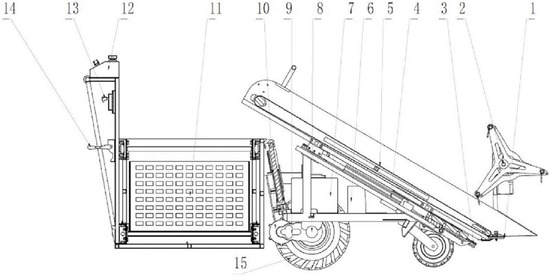
Figure 5.
Structural sketch of 4UM-120D electric leafy vegetable harvester 1. Reciprocating double-action cutter 2. Paddle mechanism 3. Slide rail 4. Electric pusher 5. Conveyor 6. Control box 7. 48 V lithium battery 8. Differential speed mechanism 9. Reducer 10. Travel drive motor 11. Collection basket 12. Control panel 13. Gear switching handles 14. Brake handle 15. Wheel.

Table 2.
Structural parameters and technical parameters of 4UM-120D electric leafy vegetable harvester.
2.1.2. Working Principle
When the electric leafy vegetable harvester was operating, a DC brushless motor drove the reciprocating double-action cutter to cut at a specific speed, and the cutter height adjusting mechanism adjusted the cutter height from the ground to within the acceptable leafy vegetable stubble height [40]. The cut leafy vegetables were first delivered to the conveying mechanism using the paddle wheel, followed by the conveying mechanism’s sending them to the rear outlet. By using the collecting basket to cover the outlet, the collection operation was then finished.
2.2. Components of the Control System for the Automatic Unloading and Replenishment of Baskets
The developed 4UM-120D electric leafy vegetable harvester served as the foundation for the automatic basket unloading and basket replenishment control system, which included a touch screen, PLC, transverse conveyor belt motor and its driver, unloading basket conveyor belt motor and its driver, feeding basket conveyor belt motor and its driver, Hall speed sensor, photoelectric sensor, pressure sensor, and other components, as shown in Figure 6.
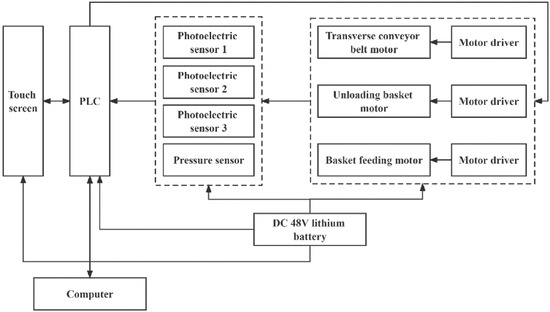
Figure 6.
Automatic basket unloading and basket replenishment control system.
2.3. Working Principle of Automatic Basket Unloading and Basket Replenishment Control
The transverse conveyor belt motor started to rotate and the leafy vegetables began to fall into the collection basket 1 after the collection baskets were discharged. The rotational speed of the transverse conveyor belt motor was adjustable and it lit up on the touch screen when the photoelectric sensor 3 lit up and the pressure sensor value was 1.5~4 kg (adjustable according to the weight of the collection basket). When photoelectric sensors 1, 2, and 3 were on and the pressure sensor value was greater than 4 kg (adjustable according to the type of harvested leafy vegetables), it indicated that the capacity of collection basket 1 had reached the expected capacity, the transverse conveyor belt motor stopped rotating and the unloading basket conveyor belt motor started rotating. When the pressure sensor value was less than 1 kg (adjustable depending on the weight of the collection basket) and none of the photoelectric sensors 1, 2, or 3 lit up, it meant that the collection basket 1 had been unloaded to the ground, the unloading basket conveyor belt motor stopped rotating and the feeding basket conveyor belt motor started rotating. When collection basket 2 (empty basket) was moved to the unloading conveyor belt and the photoelectric sensor 3 lit up once more and the pressure sensor value was 1.5~4 kg, the motor for the feeding basket conveyor belt stopped rotating and the motor for the transverse conveyor belt started rotating once more, realizing the function of automatic basket unloading and basket replenishment in this cycle. The diagram of the automatic basket unloading and basket replenishment control device is shown in Figure 7.
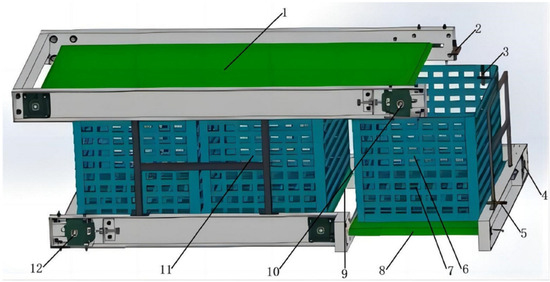
Figure 7.
Diagram of the device for the automatic basket unloading and basket replenishment control 1. Transverse conveyor belt 2. Photoelectric sensor 1 (top photoelectric sensor 1) 3. Photoelectric sensor 2 (top photoelectric sensor 2) 4. Unloading basket conveyor belt motor 5. Photoelectric sensor 3 (bottom photoelectric sensor) 6. Collection basket 1 7. Pressure sensor 8. Unloading basket conveyor belt 9. Feeding basket conveyor belt 10. Transverse conveyor belt motor 11. Collection basket 2 (empty basket) 12. Feeding basket conveyor belt motor.
The system program control flow chart is shown in Figure 8, which mainly completed the judgment of whether there was a collection basket on the unloading basket conveyor belt, the judgment of whether the capacity of the collection basket had reached the expected capacity, the judgment of whether the collection basket that had reached the expected capacity and had been unloaded to the ground, the measurement and display of the pressure on the conveyor belt for unloading basket, the measurement and display of the rotational speed of the transverse conveyor belt motor, etc.
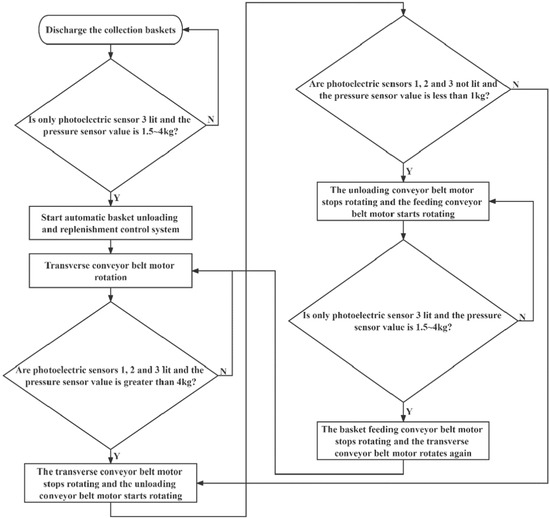
Figure 8.
Flowchart for automatic basket unloading and basket replenishment control.
2.4. Control Strategy Establishment
The automatic basket unloading and basket replenishment control system used a control strategy based on photoelectric sensors and pressure sensor synergy detection.
Photoelectric sensors were used to detect whether the capacity of the collection basket on the basket unloading mechanism had reached the desired capacity, whether the collection basket that has reached the desired capacity had been unloaded to the ground, and whether the empty basket on the basket replenishment mechanism had been transported to the basket unloading mechanism.
The pressure sensor located under the basket unloading mechanism assumed the auxiliary detection function, which was mainly used to assist in detecting whether the three results, detected by the photoelectric sensors, namely if the collection basket reached the expected capacity, been unloaded to the ground, and transported to the unloading basket conveyor belt, had resulted in misjudgment and misoperation.
The leafy vegetables conveyed by the transverse conveyor belt made a downward slanting throwing motion before entering the collection basket, but due to the complex environment of field harvesting operation, the uneven height of the monopoly surface (bed surface), etc., might make the harvester bumpy, which might lead to a slanting upward throwing motion of the leafy vegetables before entering the collection basket, which might lead to the false light action of photoelectric sensors 1 and 2 in between; if only the photoelectric sensors were used to detect whether the collection basket had reached the expected capacity, it might increase the chance of system misjudgment and false action.
There was a certain time gap between the unloading of the collection basket that had reached the expected capacity to the ground and the delivery of the empty basket to the unloading basket conveyor belt, at this time the transverse conveyor mechanism was still working, which would lead to a small number of leafy vegetables for the oblique downward throwing movement to the unloading basket conveyor belt. Therefore, if the photoelectric sensors only detected whether the collection basket to reach the expected capacity had been unloaded to the ground and whether the empty basket on the replenishment basket conveyor belt had been delivered to the unloading basket conveyor belt, it might lead to the false light action of the photoelectric sensor 3, which increased the probability of system misjudgment and false action.
All of the above were the shortcomings of the automatic basket unloading and basket replenishment control system using only photoelectric sensor detection: using only photoelectric sensor detection might lead to the false light action of the photoelectric sensors, increasing the chance of system misjudgment and false action. Pressure sensors as real-time detection of the quality of the sensor [41,42,43,44,45], could real-time display the weight of the unloading basket conveyor belt to bear, with photoelectric sensor synergy detection, which could greatly reduce the probability of system misjudgment and false action. The adjustable rotational speed of the transverse conveyor belt motor, together with the set value of the travel speed of the harvesting operation in the travel speed automatic control system, improved the stability and accuracy of the automatic basket unloading and basket replenishment control system.
2.5. Control Strategy Bench Simulation Tests
The control system was constructed as shown in Figure 9 with the main components being a touch screen, PLC, photoelectric sensor, pressure sensor, basket unloading motor, basket feeding motor, transverse conveyor belt motor, etc. This was performed to test the stability and accuracy of the control system for the automatic unloading and replenishment of baskets based on the cooperative detection of the photoelectric sensor and pressure sensor. Table 3 displays the characteristics of each functional component.
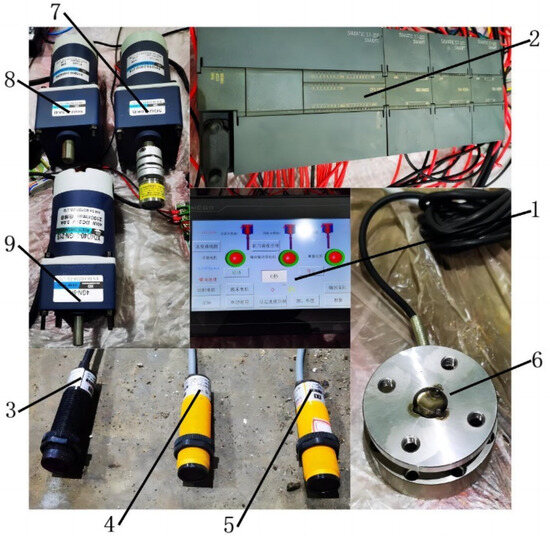
Figure 9.
Test rig for the automatic basket unloading and basket replenishment control system based on the cooperative detection of a photoelectric sensor and pressure sensor 1. Touch screen 2. PLC 3. Bottom photoelectric sensor (photoelectric sensor 3) 4. Top photoelectric sensor 1 (photoelectric sensor 1) 5. Top photoelectric sensor 2 (photoelectric sensor 2) 6. Pressure sensor 7. Transverse conveyor belt motor 8. Basket unloading motor 9. Basket feeding motor.

Table 3.
Technical parameters of the working parts of the automatic basket unloading and basket replenishment control system.
3. Results
The touchscreen interface of the control system for the automatic unloading and replenishment of baskets was shown in Figure 10. The bottom photoelectric sensor and top photoelectric sensors 1 and 2 on the touch screen were not lit and the pressure sensor value was displayed as −0.00075531 kg, which was roughly similar to 0 kg, after pressing the system start button on the touch screen, as shown in Figure 11. On the touch screen, only the basket feeding motor was on, the transverse conveyor motor and the basket unloading motor were not on, indicating that there was no collection basket on the unloading basket conveyor belt at this time; the basket feeding motor was conveying empty baskets to the unloading basket conveyor belt, extending the basket feeding action for 26 s. At 26 s, on the touch screen only the top photoelectric sensor 2 was not on: the top photoelectric sensor 1 and the bottom photoelectric sensor were on and the pressure sensor value was shown as 1.38488 kg, as shown in Figure 11. Only the transverse conveyor motor lit up on the touch screen, the basket unloading motor and the basket feeding motor did not light up, indicating that the leafy vegetables temporarily stored in the transverse conveyor belt started to fall into the collection basket at this time and had not yet reached the expected capacity of the collection basket, which would continue to extend the leafy vegetable collection action for 17 s. At 43 s, the bottom photoelectric sensor and top photoelectric sensors 1 and 2 were lit on the touch screen and the pressure sensor value was shown as 2.37229 kg, as shown in Figure 11. On the touch screen, only the basket unloading motor lit up, the transverse conveyor motor and the basket feeding motor were not lit up, indicating that the collection basket capacity had reached the expected capacity at this time and the unloading was in progress, extending the unloading action by 40 s. At 83 s, the bottom photoelectric sensor and top photoelectric sensors 1 and 2 were not lit on the touch screen and the pressure sensor value was displayed as −0.0040102 kg, which was approximately equal to 0 kg, as shown in Figure 12. On the touch screen, only the basket feeding motor lit up, the transverse conveyor motor and the basket unloading motor did not light up, indicating that the collection basket with the expected capacity had been unloaded to the ground and the basket feeding motor was transporting empty baskets to the basket unloading conveyor belt to carry out three cycles, simulating the continuous automatic basket unloading and basket replenishment control process of the system. The results are shown in Figure 11, Figure 12 and Figure 13. The system runtime and the operational status or value of each functional component are shown in Table 4. As could be seen from Table 3, the bench simulation tests of the automatic basket unloading and basket replenishment control system based on the photoelectric sensor and pressure sensor cooperative detection control strategy were free of misjudgment and misoperation, which improved the stability, accuracy, and rapidity of the system.
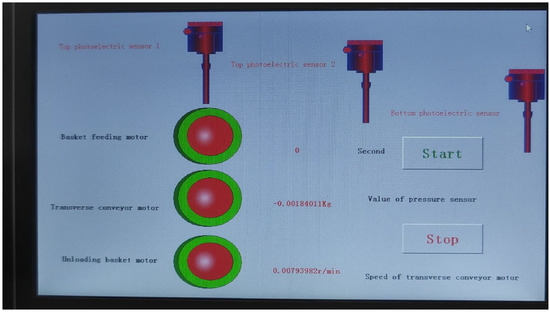
Figure 10.
Touch screen interface of the control system for the automatic unloading and replenishment of baskets.
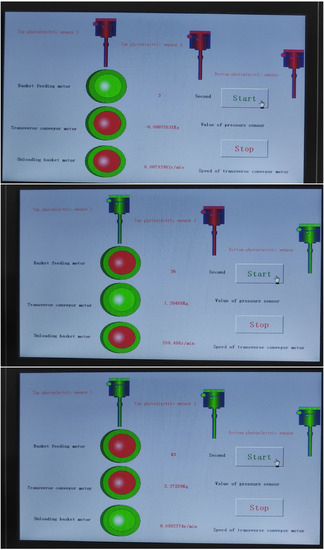
Figure 11.
Touch screen interface for basket feeding action, leafy vegetable collection action, and basket unloading action during the first round of the automatic basket unloading and basket replenishment control process.
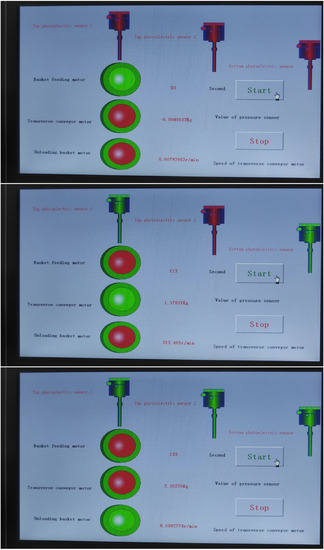
Figure 12.
Touch screen interface for basket feeding action, leafy vegetable collection action, and basket unloading action during the second round of the automatic basket unloading and basket replenishment control process.

Figure 13.
Touch screen interface for basket feeding action, leafy vegetable collection action, and basket unloading action during the third round of the automatic basket unloading and basket replenishment control process.

Table 4.
The system runtime and the operational status or value of each functional component.
4. Discussion
The study is concerned with the design and experimental research of a sustainable agricultural machinery control system. In the current domestic leafy vegetable harvesting operations, the majority of manual unloading collection baskets and replenishment collection baskets, as well as manual unloading and replenishment baskets, need to stop working. According to the actual harvesting situation, the average cycle of manual unloading and the replenishment of baskets once is about 15 s; the machine needs to stop in the 15 s, seriously affecting the harvesting efficiency and the environment while increasing the work intensity. In the actual operation process, the operator’s professional level is relatively low, making it challenging to keep the leafy vegetable harvester in stable working condition for an extended time. Additionally, the manual unloading and replenishment of baskets is slow and other situations arise, which not only increase the operator’s workload but also have a significant negative impact on the effectiveness of leafy vegetable harvesting and the environment. The control system developed in this study allows for the automatic unloading of collection baskets and the replenishment of collection baskets without stopping the machine, which not only reduces the operator’s workload but also has a significant positive impact on the effectiveness of leafy vegetable harvesting and the environment. Although the TC110E leafy vegetable harvester’s use of airflow to convey the cut leafy vegetables to the rear collection bag for harvesting allowed the cut leafy vegetables to be conveyed without contact and improved the quality of the harvest, the cut leafy vegetables were prone to be blown to the ground, which reduced the efficiency of the harvest. Although the leafy vegetable harvester developed by Guangming Qin (2016) et al. could remove impurities on the surface of leafy vegetables as well as ensure the orderliness of leafy vegetable conveyance, it still manually unloaded the filled collection baskets and manually replenished the empty baskets, which made the harvesting efficiency low. The automatic unloading and replenishment control system based on the coordinated detection of photoelectric sensors and pressure sensors designed by this research could realize automatic unloading and replenishment of collection baskets without stopping the machine and without false judgment and false action, which greatly improved the harvesting efficiency and the environment. However, the control system for the automatic unloading and replenishment of baskets based on the cooperative detection control strategy of the photoelectric sensor and pressure sensor could be error-free and avoided misoperation only through bench simulation tests, without further field tests to verify the accuracy of the simulation test results.
5. Conclusions
This paper took the developed 4UM-120D electric leafy vegetable harvester as the research object, conducted an in-depth study on the control system for the automatic unloading and replenishment of baskets at the back end of the electric leafy vegetable harvester and proposed the automatic basket unloading and basket replenishment control method based on the cooperative detection of a photoelectric sensor and pressure sensor. This paper first studied and analyzed the working principle and system composition of automatic basket unloading and basket replenishment control and then designed and built a control system for the automatic unloading and replenishment of baskets based on the cooperative detection of photoelectric sensors and pressure sensors. This aimed to verify the probability of misjudgment and misoperation of the control system for the automatic unloading and replenishment of baskets through the bench simulation test and to improve the system performance. The simulation results showed that the automatic basket unloading and basket replenishment control system based on the cooperative detection control strategy of the photoelectric sensor and pressure sensor could be error-free and avoid misoperation, which effectively improved the stability, accuracy, and rapidity of the system. Subsequent field tests of automatic basket unloading and basket replenishment control, as well as field tests of the harvester travel speed and the transverse conveyor belt conveying speed in the control system for the automatic unloading and replenishment of baskets at low, medium, and high speed, would be carried out to analyze the working effect of the system to further verify the accuracy, reliability, and stability of its functions.
Author Contributions
Conceptualization, L.H. and G.W.; methodology, J.Y.; software, W.C.; validation, L.H., J.P. and W.C.; formal analysis, W.C.; investigation, H.S. and Y.W.; resources, G.B.; data curation, W.C.; writing—original draft preparation, W.C.; writing—review and editing, G.W.; visualization, X.W.; supervision, G.W.; project administration, L.H.; funding acquisition, G.W. All authors have read and agreed to the published version of the manuscript.
Funding
This research was supported by the earmarked fund for CARS-10-Sweetpotato, grant number CARS-10 (funder: Lianglong Hu). This research was also supported by the Key R and D Program of Jiangsu Province: The Key R and D technologies for efficient green production of sweet potato, grant number BE2021311 (funder: Lianglong Hu).
Institutional Review Board Statement
Not applicable.
Informed Consent Statement
Not applicable.
Data Availability Statement
Not applicable.
Acknowledgments
This work was supported by the earmarked fund for CARS-10-Sweetpotato (CARS-10). The laboratory was provided by the Nanjing Institute of Agricultural Mechanization, Ministry of Agriculture and Rural Affairs. Thanks to Lianglong Hu for his guidance. Thanks to Xinhua Wei, Gongpu Wang, Jiwen Peng, Jianning Yuan, Guocheng Bao, and Yemeng Wang for their experimental program discussion and experimental assistance. This work is also supported by the Key R and D Program of Jiangsu Province: The Key R and D technologies for efficient green production of sweet potato (BE2021311).
Conflicts of Interest
The authors declare no conflict of interest.
References
- Jin, Y.; Xiao, H.; Xiao, S.; Xu, M.; Ding, W.; Liu, D. Research status and development trend of leafy vegetable harvesting technology and equipment. China Agric. Sci. Technol. Her. 2018, 20, 72–78. [Google Scholar] [CrossRef]
- Xiao, H.; Jin, Y.; Song, Z.; Xia, X.; Zhao, Y.; Mei, S.; Yang, G. Analysis of the application and development trend of stem and leaf vegetable production technology and equipment. Chin. Veg. 2018, 6, 17–21. [Google Scholar] [CrossRef]
- Bai, S.; Yuan, Y.; Niu, K.; Shi, Z.; Zhou, L.; Zhao, B.; Wei, L.; Liu, L.; Zheng, Y.; An, S.; et al. Design and Experiment of a Sowing Quality Monitoring System of Cotton Precision Hill-Drop Planters. Agriculture 2022, 12, 1117. [Google Scholar] [CrossRef]
- Bian, L.; Li, J.; Ding, X. Mechanized harvesting technology and research of leafy vegetables. Agric. Equip. Technol. 2015, 41, 22–24. [Google Scholar]
- Miao, P.; Zuo, Z.; Mao, H.; Han, L.; Wang, T.; Wei, F.; Shi, X. Research on automatic row alignment control system of electric leafy vegetable harvester. Agric. Mech. Res. 2022, 44, 84–89. [Google Scholar] [CrossRef]
- Zhang, J.; Zhou, F.; Jing, C.; Tao, J. Analysis of the research status and development trend of leafy vegetable harvesting machinery. South. Agric. Mach. 2020, 51, 31. [Google Scholar]
- Li, Y.; Xue, Z.; Xu, L.; Li, Y.; Qiu, J.; Wang, Y. Research progress on the monitoring methods of the separating loss in grain combine harvester. J. Intell. Agric. Mech. 2020, 1, 13–23. [Google Scholar] [CrossRef]
- Hu, T.; Qi, X.; Li, H.; Yang, S.; Wang, Y.; Xu, S.; Bai, M. Seed movement characteristics and filling performance of seed metering device for baby bok choy based on CFD-DEM approach. J. Intell. Agric. Mech. 2020, 1, 32–43. [Google Scholar] [CrossRef]
- Wen, H.; Chen, X.; Pan, F. Development of precision seeder for drip irrigation under plastic film in Xinjiang. J. Intell. Agric. Mech. 2020, 1, 7–12. [Google Scholar] [CrossRef]
- Miao, P. Research on the Intelligent Control System of Electric Leafy Vegetable Harvester; Jiangsu University: Zhenjiang, China, 2020. [Google Scholar]
- Mao, T.; Dong, S.; Xue, J. Dynamic function allocation of agricultural robot vehicle controlled by man-machine cooperation. J. Intell. Agric. Mech. 2020, 1, 24–31. [Google Scholar] [CrossRef]
- Shen, G.; Wang, G.; Hu, L.; Yuan, J.; Wang, Y.; Wu, T. Development overview and outlook of stem tip harvesting device for sweet potato vegetable. J. Chin. Agric. Mech. 2019, 40, 26–32. [Google Scholar] [CrossRef]
- Mei, S.; Xiao, S.; Jiang, Q.; Lü, X.; Tong, Y. Design and experiment of self-propelled precision sowing and fertilizing control system for vegetables. J. Intell. Agric. Mech. 2022, 3, 54–61. [Google Scholar] [CrossRef]
- Sun, Y.; Chen, G.; Li, Q.; Sun, Y.; Shen, J.; Yan, N. Application and development trend of intelligent agriculture. J. Intell. Agric. Mech. 2020, 1, 56–59. [Google Scholar] [CrossRef]
- Guo, W.; Chen, S.; Li, J. Development of a small leafy vegetable harvesting machine. Agric. Equip. Technol. 2011, 37, 13–15. [Google Scholar]
- Ding, X.; He, B.; Xue, Z. Research and development of small leafy vegetable harvester and market exploration. Jiangsu Agric. Mech. 2014, 2, 40–42. [Google Scholar] [CrossRef]
- Zhang, K.; Hu, Y.; Yang, L.; Zhang, D.; Cui, T.; Fan, L. Design and test of automatic row alignment system for corn harvester. Trans. Chin. Soc. Agric. Mach. 2020, 51, 103–114. [Google Scholar] [CrossRef]
- Chen, G.; Li, Q.; Sun, Y.; Sun, Y.; Shen, J. Research on automatic row alignment control system of corn combine harvester. J. Chin. Agric. Mech. 2016, 37, 191–194 + 280. [Google Scholar] [CrossRef]
- Chen, G.; Sun, Y.; Li, Q.; He, Q.; Sun, Y. Research on automatic row direction self-correction system of corn harvester. Agric. Mech. Res. 2019, 41, 191–195. [Google Scholar] [CrossRef]
- Wang, S.; Hu, Z.; Peng, B.; Wu, H.; Gu, F.; Wang, H. Simulation of automatic row detection mechanism of sugar beet harvester based on ADAMS. Trans. Chin. Soc. Agric. Mach. 2013, 44, 62–67. [Google Scholar] [CrossRef]
- Liu, D.; Xiao, H.; Jin, Y. Research status and development countermeasures of orderly harvesting machinery for leafy vegetables. Jiangsu Agric. Sci. 2019, 47, 27–31. [Google Scholar] [CrossRef]
- Shentu, L.; Liu, H.; Wu, X.; Sun, X.; Zhang, W. Design and analysis of cam mechanism of sweet potato transplanter based on Creo. J. Intell. Agric. Mech. 2020, 1, 11–18. [Google Scholar] [CrossRef]
- Wei, G.; Xia, L.; Liu, Y. Design and test of 4VYF-120 hand-held leafy vegetable harvester. Jiangsu Agric. Mech. 2020, 6, 9–12. [Google Scholar] [CrossRef]
- Wu, Y. Design of Greenhouse Celery Harvester; Ningxia University: Yinchuan, China, 2018. [Google Scholar]
- Lv, Q.; Ma, J. The current situation and market status of vegetable harvesters at home and abroad. Hebei Agric. Mach. 2019, 4, 28–29. [Google Scholar] [CrossRef]
- Wang, S.; Hu, Z.; Wu, H.; Peng, B.; Xie, H.; Gu, F. Design and test of automatic row-to-row hydraulic corrective actuation system for sugar beet harvester. Agric. Mech. Res. 2016, 38, 155–162. [Google Scholar] [CrossRef]
- Wang, S.; Hu, Z.; Wu, H.; Peng, B.; Wang, H.; Wu, F. Simulation and test of automatic row alignment control system design for sugar beet harvester based on Proteus. J. Chin. Agric. Mech. 2014, 35, 35–40. [Google Scholar] [CrossRef]
- Wu, H.; Hu, Z.; Peng, B.; Gu, F.; Wang, H.; Wang, B. Development of automatic row alignment system for towed sugar beet combine harvester. Trans. Chin. Soc. Agric. Eng. 2013, 29, 17–24. [Google Scholar] [CrossRef]
- Gao, F.; Wang, Z.; Bai, X.; Yang, L. Design of automatic row detection device for self-propelled sugar beet combine harvester. Agric. Mech. Res. 2020, 42, 69–76. [Google Scholar] [CrossRef]
- Li, T.; Zhou, J.; Xu, W.; Li, Q.; Zhang, H.; Qin, X.; Li, N.; Li, W.; Guo, D. Development of 4UGS2 two-row sweet potato harvester. Trans. Chin. Soc. Agric. Eng. 2018, 34, 26–33. [Google Scholar] [CrossRef]
- Jin, C.; Guo, F.; Xu, J.; Li, Q.; Chen, M.; Li, J.; Yin, X. Optimization of operating parameters of soybean combine harvester. Trans. Chin. Soc. Agric. Eng. 2019, 35, 10–22. [Google Scholar] [CrossRef]
- Yan, W.; Hu, Z.; Wu, N.; Xu, H.; You, Z.; Zhou, X. Optimization and test of parameters of film conveyor mechanism of shovel-screen residual film recycling machine. Trans. Chin. Soc. Agric. Eng. 2017, 33, 17–24. [Google Scholar] [CrossRef]
- Lv, J.; Yi, S.; Tao, G.; Mao, X. Optimization and test of parameters of split slide knife furrow opener for potato planter. Trans. Chin. Soc. Agric. Eng. 2018, 34, 44–54. [Google Scholar] [CrossRef]
- Ma, J.; Song, D.; Lin, Z.; Gao, X. Research on measurement and control system for agricultural facilities group based on the Internet of Things. J. Intell. Agric. Mech. 2020, 1, 44–50. [Google Scholar] [CrossRef]
- Han, Y.; Song, Z.; Chen, Q. Design and experiment of 4CJ-1200F intelligent tea plucking machine. J. Intell. Agric. Mech. 2022, 3, 1–6. [Google Scholar] [CrossRef]
- Xu, S.; Qin, G.; Shen, D. Development of a new type of leafy stem vegetable harvester. J. Chin. Agric. Mech. 2016, 37, 18–21. [Google Scholar] [CrossRef]
- Shi, Y.; Zhang, Y.; Wang, X.; Xu, J. Development and prototype testing of an environmentally friendly self-propelled orderly harvesting machine for Artemisia annua. J. Chin. Agric. Mech. 2018, 39, 17–21. [Google Scholar] [CrossRef]
- Li, X.; Zhang, J.; Yuan, Y.; Zhao, Y. Design and test of intelligent control system for small electric leafy vegetable harvester. Agric. Mech. Res. 2020, 42, 83–87. [Google Scholar] [CrossRef]
- Chen, W.; Wang, G.; Hu, L.; Yuan, J.; Wu, W.; Bao, G.; Yin, Z. PID-Based Design of Automatic Control System for a Travel Speed of the 4UM-120D Electric Leafy Vegetable Harvester. Sustainability 2022, 14, 14066. [Google Scholar] [CrossRef]
- Chen, W.; Hu, L.; Wang, G.; Yuan, J.; Bao, G.; Shen, H.; Wu, W.; Yin, Z. Design of 4UM-120D Electric Leafy Vegetable Harvester Cutter Height off the Ground Automatic Control System Based on Incremental PID. Agriculture 2023, 13, 905. [Google Scholar] [CrossRef]
- Li, J.; Shang, Z.; Li, R.; Cui, B. Adaptive Sliding Mode Path Tracking Control of Unmanned Rice Transplanter. Agriculture 2022, 12, 1225. [Google Scholar] [CrossRef]
- Shishmarev, V.Y. Automation of Production Processes in Mechanical Engineering: Textbook; Academy: Moscow, Russia, 2007. [Google Scholar]
- Kayad, A.; Paraforos, D.; Marinello, F.; Fountas, S. Latest Advances in Sensor Applications in Agriculture. Agriculture 2020, 10, 362. [Google Scholar] [CrossRef]
- Jurišić, M. Sensors and Their Application in Precision Agriculture. Teh. Glas. 2021, 15, 529–533. [Google Scholar] [CrossRef]
- Uljaev, E.; Udabydullaev, U.; Abdulkhamidov, A.; Erkinov, S. Analysis and selection of methods and sensors for controlling the width of the working slot of the harvesting device CP. Tech. Sci. Innov. 2021, 2021, 9. [Google Scholar] [CrossRef]
Disclaimer/Publisher’s Note: The statements, opinions and data contained in all publications are solely those of the individual author(s) and contributor(s) and not of MDPI and/or the editor(s). MDPI and/or the editor(s) disclaim responsibility for any injury to people or property resulting from any ideas, methods, instructions or products referred to in the content. |
© 2023 by the authors. Licensee MDPI, Basel, Switzerland. This article is an open access article distributed under the terms and conditions of the Creative Commons Attribution (CC BY) license (https://creativecommons.org/licenses/by/4.0/).